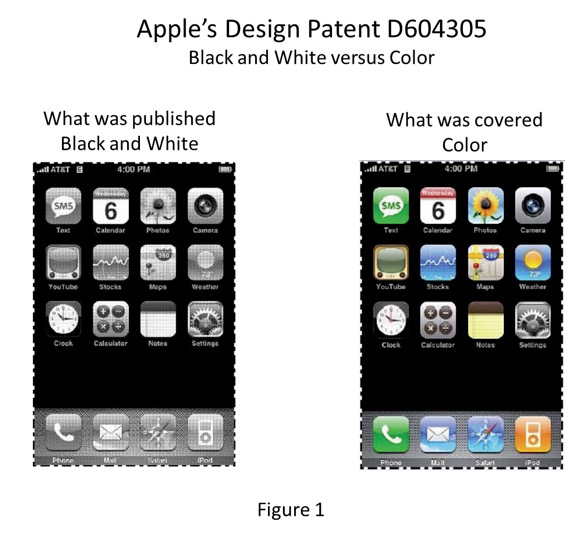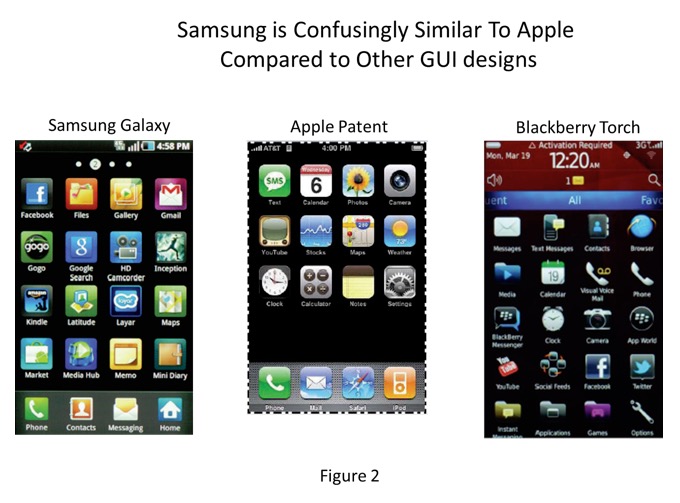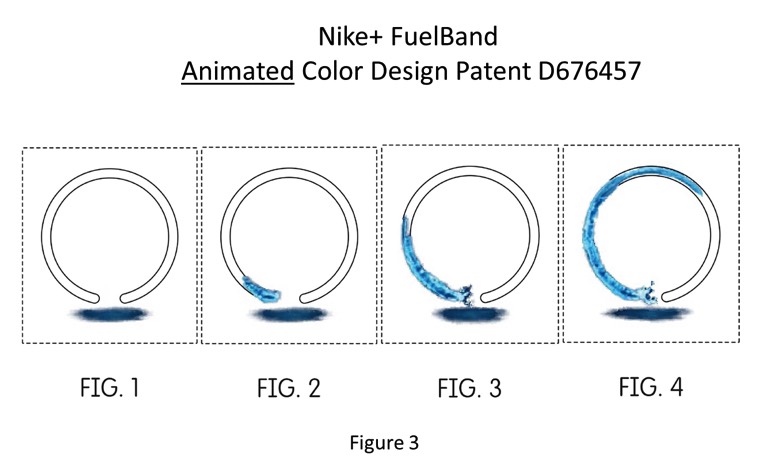Editor’s note: This is the second in a four part series on Strong Design Patents. In this series, author Mark Nowotarski looks at Apple design patents and the strategies behind building a strong design patent portfolio. Part 1 was The Power of the Broken Line. Subsequent articles will discuss “The Power of the Portfolio” followed by “The Power of Policing.”
Color matters. For example, the success of Apple Computer’s recent lawsuit against Samsung was largely due to Apple’s design patent on a single color image of their iPhone graphical user interface (GUI). This design patent accounted for $725 million of the $1 billion jury verdict on damages. There were many differences between Samsung’s Galaxy phone GUI and Apple’s patented GUI, but the overall color schemes were sufficiently similar to convince the jury that there was a likelihood of confusion between the Samsung GUI and the Apple patented GUI. Hence Samsung infringed the design patent, and Apple was entitled to all of the profits Samsung made from the confusingly similar phones.
You can patent the look and feel of a graphical user interface. More precisely, you can patent an electronic device that displays a graphical user interface of a certain design by filing an image of the GUI with the USPTO as a “design patent.” If the overall design is new and not obvious, the design patent will be allowed and is valid for 14 years from the issue date. For the next 14 years, no one will be able to make, use or sell an electronic device in the US that displays a graphical user interface that is confusingly similar to yours. It doesn’t matter what the device is.
Ironically, color design patents are still published in black and white. The front page of a design patent will inform you, however, that the USPTO has a color image on file. By downloading the originally filed images on the USPTO’s Public PAIR data base, you can see what the color design patent actually covers. The originally filed color images can then be downloaded from the “supplemental content” tab of the PAIR record for each patent. [i]
Figure 1 above shows the images from Apple’s design patent D604305, “Graphical User Interface for a Display Screen or Portion Thereof”. The black and white image is what was published. The color image was downloaded from Public PAIR and shows what’s covered. Apple filed this design patent in June of 2007. Samsung introduced its family of Galaxy phones in June of 2010. Apple filed suit against Samsung in April of 2011 alleging, among other things, that many members of the Galaxy family of phones were programed by Samsung to display a GUI confusingly similar Apple’s.
Figure 2 shows one of the comparisons Apple made at trial between the accused Samsung design on the left and a Blackberry Torch GUI on the right. The patented Apple GUI is in the middle. There are many differences between the Samsung GUI and the Apple GUI but relative to a Blackberry, the differences are not strong enough to prevent confusion with the Apple. There is a common misunderstanding that if you change one little aspect of a design you get around a design patent. That’s not true. Infringement of a design patent is based on whether or not there is a likelihood of confusion between the accused design and the patented design in light of other designs for articles with similar functionality. Confusion is subjective, and you can still have confusion even if there are differences. You need to compare an accused design with other designs, as well as the patented design, to see if the accused design is confusingly similar to the patented design.
In addition to a Graphical User Interface, you can also protect an Animated User Interface with a design patent. To protect an animation, you file successive images of the animation as separate color images.
Figure 3 shows four of the color images of a design patent that Nike has on the Animated User Interface for their Nike+ FuelBand app., D676457, “Display Screen with Animated User Interface”. Each figure shows a sequential image in the animation. This patent is part of a larger portfolio of about 20 design patents all protecting Nike’s FuelBand app.
The use of color design patents is growing fast, particularly for computer generated images. Similarities in color schemes can outweigh differences in shapes if an accused image is more similar in color pallet to a patented design than it is to other available designs. It’s a little more effort to file color images, but the increased strength of coverage can be well worth it.
For more information about design patents please see: Design Patents Protect an Invention’s “Look” and “Feel.”
PREVIEW: Next week in “Strong Design Patent III: The Power Portfolio” we will look at Apple’s overall strategy for building strong design patent portfolios. Apple only asserted 4 design patents against Samsung, but they had hundreds to choose from. The timing and content of those design patents relative to each other helped Apple build their strong portfolio.
[i] Apple filed their iPhone design patent with 193 different screen shots. The patent examiner made them pick one for the patent. The rest have to be refiled as separate patents. This is called a “restriction requirement”. Apple picked the home screen image for this patent and is now getting separate design patents on the other screen shots. They have about 50 issued so far with more still pending.

![[IPWatchdog Logo]](https://ipwatchdog.com/wp-content/themes/IPWatchdog%20-%202023/assets/images/temp/logo-small@2x.png)





![[Advertisement]](https://ipwatchdog.com/wp-content/uploads/2024/04/UnitedLex-May-2-2024-sidebar-700x500-1.jpg)
![[Advertisement]](https://ipwatchdog.com/wp-content/uploads/2024/04/Artificial-Intelligence-2024-REPLAY-sidebar-700x500-corrected.jpg)
![[Advertisement]](https://ipwatchdog.com/wp-content/uploads/2024/04/Patent-Litigation-Masters-2024-sidebar-700x500-1.jpg)

![[Advertisement]](https://ipwatchdog.com/wp-content/uploads/2021/12/WEBINAR-336-x-280-px.png)
![[Advertisement]](https://ipwatchdog.com/wp-content/uploads/2021/12/2021-Patent-Practice-on-Demand-recorded-Feb-2021-336-x-280.jpg)
![[Advertisement]](https://ipwatchdog.com/wp-content/uploads/2021/12/Ad-4-The-Invent-Patent-System™.png)






Join the Discussion
5 comments so far.
Patent710
February 11, 2014 11:37 amMark, I have a client that manufactures apparel and would like to file a design application.
The client would like the color “blue” to form the basis for receiving a design application for his apparel.
Can “blue” in fact be used to obtain a design patent?
If so, what steps do I need to take to file a design application?
Any help is greatly appreciated.
Mark Nowotarski
August 12, 2013 08:13 amDaniel,
You are right. It certainly does sound like trademark infringement. I based my comment on Judge Koh’s instructions to the jury. You can find them on page 63 https://docs.google.com/file/d/0B1KB3j_eVkNwMThnazBuWmN4YlU/edit
Does her actual words still look essentially like a trade dress or trademark test?
Daniel L. Dwes
August 7, 2013 02:29 pmYou state:
“Infringement of a design patent is based on whether or not there is a likelihood of confusion between the accused design and the patented design in light of other designs for articles with similar functionality. Confusion is subjective, and you can still have confusion even if there are differences. You need to compare an accused design with other designs, as well as the patented design, to see if the accused design is confusingly similar to the patented design.”
Since when was the infringement test for design patents the same as that for trade dress and trademarks? The infringement analysis between the two is very different. Admittedly, Apple v. Samsung involved both design patent and trade dress infringement claims, but the court did not make the infringement analysis that you are asserting for the ‘305 design patent.
Mark Nowotarski
August 7, 2013 08:23 amPatent leather,
Yes, but you can do them one at a time. You file the first design patent in color and then refile a continuation or divisional with black and white images or even a line drawing of the outline of the shape.
We will cover this in next week’s article on building design patent portfolios.
Mark
patent leather
August 6, 2013 08:10 amMark, interesting article. Do you think there is something to be said for filing two design patents on the same matter, one in color and one in black/white? I can see how the color application in some instances might not infringe while the b/w application would (e.g., same overall layout but totally different colors). What do you think?